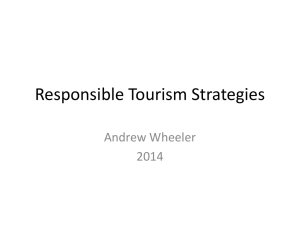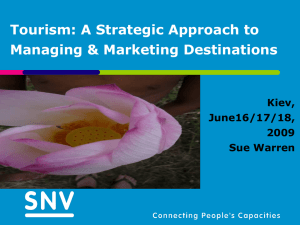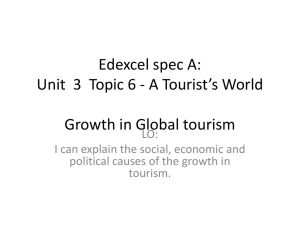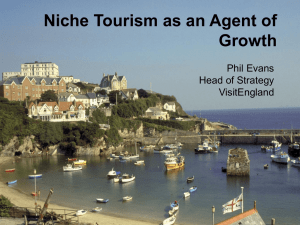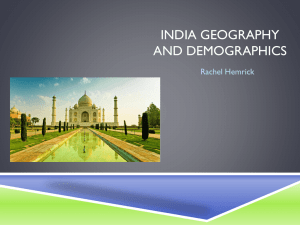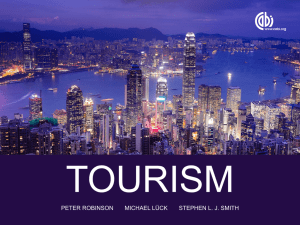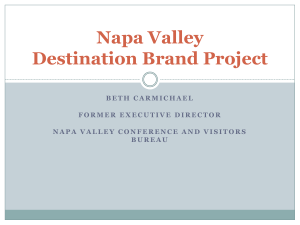Components of the Overall Tourism Product
advertisement
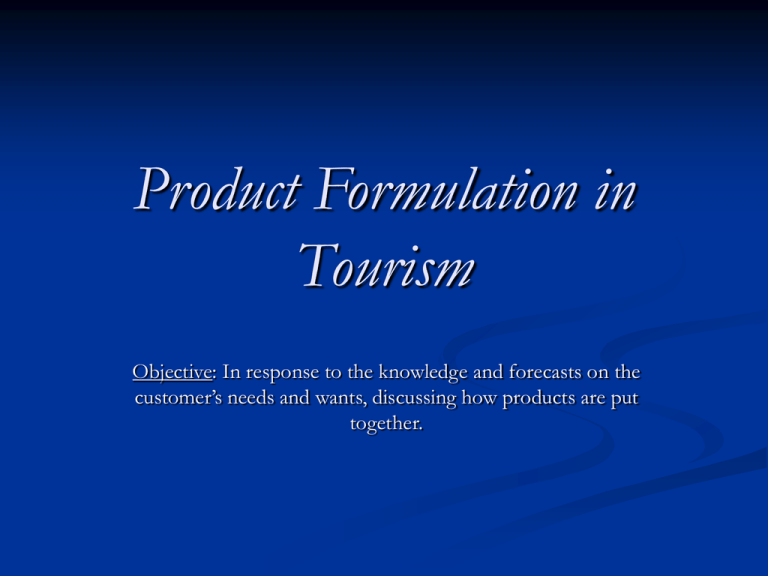
Product Formulation in Tourism Objective: In response to the knowledge and forecasts on the customer’s needs and wants, discussing how products are put together. Understanding Tourism Products There are two different dimensions for understanding tourism products; The overall tourism product; as far as the tourist is concerned, the product covers the complete experience from the time he leaves home to the time he returns to it. The product of individual tourism businesses; organizations in the industry have a much narrower view of the products they sell, they focus primarily on their own services. Components of the Overall Tourism Product From the standpoint of a potential customer, the product may be defined as a bundle or package of tangible and intangible components. The packaged is perceived by the tourist as an experience. Destination attractions and environment Destination facilities and services Accessibility of the destination Images of the destination Price to the customer Destination attractions and environment They determine customer choice and influence prospective buyers’ motivations. They include; Natural attractions Built attractions (e.g. The World) Cultural attractions Social attractions Destination facilities and services They make it possible for visitors to stay and in other ways enjoy and participate in attractions. They include; Accommodation units Restaurants, bars and cafes Transport at the destination Sports (interest) activity Other facilities (e.g. language schools) Retail outlets Other services (e.g. information services) Accessibility of the destination These are the private and public transport aspects of the product that determine the cost, speed and convenience. They include; Infrastructure (roads, airports etc) Equipment (size, speed of transport etc) Operational factors (routes, frequency etc) Government regulations Images and perceptions of the destination The attitudes and images customers have towards products strongly influence their buyer decision. Destination images are not necessarily grounded in experience or facts but they are always powerful motivators in leisure and travel and tourism. Closely linked in prospective customers’ minds. All destinations have images, often based on historic rather than current events It is an essential objective of destination marketing to sustain, alter, or develop images in order to influence prospective buyers’ expectations. The images of tourism businesses within destinations are often closely related to the destination image (e.g. Las Vegas) Price to the customer Most destinations offer a range of products and appeal to a range of segments, price in the travel and tourism industry covers a very wide range. Price varies by season, by choice of activities and internationally by exchange rates as well as by distance traveled, transport mode and choice of facilities and services. Components of Specific Products Core product; essential service or benefit designed to satisfy the identified needs of target customer segments. Tangible product; the specific offer for sale slating what a customer will receive for his money. Augmented product; comprises all the forms of added value to the formal product offers to make them more attractive. Branding and Product Positioning Image, typically communicated by branding, is identified as one of the components in the overall tourism product and as a vital element within the augmented product development and marketed by individual businesses in the industry. Tourism products are essentially intangible and need to be communicated in ways that influence consumers’ perceptions. Branding provides the core attributes of; Statement of ownership. Means of identifying a product or service for purchasers and distinguishes it from that of competitors. Symbol of shorthand device to which expectations of quality could be attached. A brand is defined as “a name, symbol, design or some combination, which identifies the ‘product’ of a particular organization as having a sustainable differential advantage”. In practice, a strong brand has to exist in the minds of consumers as a fusion of readily understood values and benefits. A brand offers the consumer relevant added value, a superior proposition that is distinctive from competitors (competitive advantage). Consumers are prepared to pay a price premium for strong brands. Forms the basis of the “positioning”. Advantages of Branding for Travel and Tourism Helps reduce medium and long-term vulnerability to the unforeseen external events Reduces risk for the consumer, offers guarantee, signals expected quality and performance of an intangible product Provides a common understanding and some unity of purpose for staff etc Branding is a strategic weapon for long-range planning in tourism Useful Links and Sources Kotler, P.; Bowen, J. and Makens, J. (1999). Marketing for Hospitality and Tourism (2nd ed.). Prentice Hall. NJ. Kotler, P. and Armstrong, G. (2006) Principles of Marketing (11th ed.). Prentice Hall. NJ. Middleton, V.T.C. (2004) Marketing in Travel and Tourism (3rd ed). Elsevier. Oxford. http://www.hotelsmag.com http://www.tourism.bilkent.edu.tr/~eda




